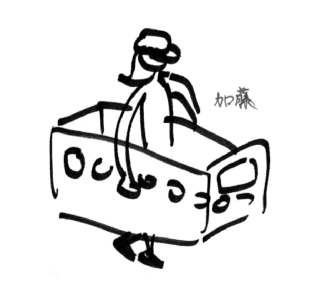今日推薦開源項目:《狗勾 dog-api-images》
今日推薦英文原文:《What』s A Human-Powered Computer?》

今日推薦開源項目:《狗狗 dog-api-images》傳送門:項目鏈接
推薦理由:這個項目是 dog-api 中的狗狗圖片倉庫,顧名思義這裡有極其大量的狗狗元素,包含各種各樣類別的狗狗圖片,對於那些喜歡狗狗但是沒法養的人來說,這個倉庫或許能拿來望梅止渴,補充自己的狗狗能量。
今日推薦英文原文:《What』s A Human-Powered Computer?》作者:John Maeda
原文鏈接:https://johnmaeda.medium.com/whats-a-human-powered-computer-14997285111
推薦理由:事實證明計算機是真的比人快很多
What』s A Human-Powered Computer?
In the spring of 1993, my experiences as a hardware and software engineer collided with the art world as an installation in Kyoto benefitting from the educational direction of edutech pioneer Nobuyuki Ueda. Having worked for too long in the abstract world of electricity and cyberspace, I hungered to see it made real, in order to understand it better. Thus was born the Human Powered Computer Experiment, which was 「performed」 by Dr. Ueda』s graduate students in a two-day long workshop where human beings embodied the working components of a computer.
At the time computers still had disk drives, so the entire system started up by turning on a power switch, and then placing a giant cardboard disk into a slot through a partition. On one side of the divider sat the computer user; the other half was for the human-powered computation to happen. The performance area spanned two floors of empty space so that visitors could view what was occurring on both sides at the same time.

When the power switch (made out of paper) was flipped to 「ON,」 the corresponding person playing the 「power manager」 role was watching and followed a handwritten script:

She was waiting for the disk to be placed into the slot so that information could be read off of the disk』s platter through a window — just like the way a computer would read information from a floppy disk.

Each of the 「sectors」 of the floppy disk were pieces of paper that would spin into view one by one.
As information was being read off of the disk, the bus would then deliver the data to the relevant component — CPU, memory, mouse driver, GPU, etc — to do the work of 「booting」 the computer to become operational.

The 「bus」 role involved carrying information on whiteboard cards to different components inside the computer.
A Human-Powered Computer Is Slooooow
The computer was programmed to track the position of the mouse (a cardboard box on a grid) and to display the corresponding location on the computer screen. That means when you moved the mouse, the cursor graphic would move on the video screen in a corresponding way — which happens fluidly on a regular computer. Writing the program was a matter of taping instructions onto the cardboard platter of the disk, and then inserting it into the partition from the user side to the computation side. The disk drive picked up the disk, wore it, and then proceeded to spin the disk platter to the first sector.
The bus carried information on whiteboard cards between different components of the computer.
The bus took the first instruction packet and then delivered it to the right destinations, and after three hours of delivering subsequent cards of information, it finally went to read an x-y coordinate from the mouse manager. The bus carried that information over to the video manager, and subsequently the screen was updated with the new position. One can imagine how unfavorable it would be for their computer to take three hours to move the position of their mouse on screen. You can watch a reenactment of those three hours — condensed to an artistically reinterpreted three minutes — in this video by Dr. Ueda』s team(https://vimeo.com/2745677).
What learnings came from the experiment?
The big takeaway was that computers are extremely fast, and when you try to replicate that with human beings, you see how slow we move by comparison. Another thing we noticed was when one of the first computer programs I wrote 「crashed.」 But it was okay because we had a good excuse to take a lunch break to refresh ourselves, and then noted how the real computer didn』t need any rest at all.One outcome that I didn』t expect was how insightfully Professor Ueda』s students — all pursuing Education degrees — could articulate how to improve the computer』s operation with suggestions like this:
- Couldn』t there be two buses instead of just one to speed things up?
- Why wasn』t the video manager closer to the CPU so it waits less often?
The underlying motivation for running this experiment came from learning about the Bauhaus and its approach to finding new ways to leverage new electrical, chemical, and mechanical technologies during the 1st and 2nd Industrial Revolutions in service of human beings. The 3rd and 4th Industrial Revolutions are about computing and the need for more people who can speak machine (and human). What are these four Industrial Revolutions? I』ll cover that in my next post.
下載開源日報APP:https://openingsource.org/2579/
加入我們:https://openingsource.org/about/join/
關注我們:https://openingsource.org/about/love/
